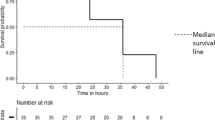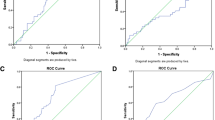Abstract
Background
This study aimed to investigate gestational age-specific hematological features in preterm infants with necrotizing enterocolitis (NEC) and identify predictive hematological biomarkers for surgical NEC.
Methods
We conducted a retrospective study comparing gestational age (GA)-specific clinical data between medical NEC (m-NEC) and surgical NEC (s-NEC) subgroups, stratified by GA as <28 weeks, 28 ≤ GA < 32 weeks, and 32 ≤ GA < 37 weeks. Multivariate logistic analysis and receiver operating characteristic curve were used to identify the independent predictors of s-NEC.
Results
In comparison to m-NEC at NEC onset, s-NEC infants exhibited the following findings: In GA < 28 weeks, s-NEC infants had lower platelet counts. In 28 ≤ GA < 32 weeks, lower absolute lymphocyte counts, and significant percent drop in platelets, lymphocytes, and monocytes were observed. In 32 ≤ GA < 37 weeks, lower absolute lymphocyte counts and significant percent drop in lymphocytes were found. Independent predictors were able to distinguish s-NEC from m-NEC. The area under the curve (AUC) for platelet counts in GA < 28 weeks was 0.880, while C-reactive protein in 28 ≤ GA < 32 weeks had an AUC of 0.889. The AUC for lymphocyte counts in 32 ≤ GA < 37 weeks was 0.892.
Conclusion
This study identified hematological abnormalities in the development of NEC based on gestational age. Independent predictors may help clinicians distinguish surgical NEC from medical NEC.
Impact
Necrotizing enterocolitis (NEC) patients with different gestational ages (GA) exhibit different hematological features and independent predictors of surgical NEC differ among different GAs. Our research made the current studies about peripheral hematological features with NEC more complete by analyzing peripheral data collected within 24 h of birth, at day 5–7, day 3–4, day 1–2 before NEC onset, at the time of NEC onset, day 1, day 2, day 3, day 4–5, day 6–7 after NEC onset. Our study is helpful to clinicians in developing a more detailed diagnostic strategy based on GA for the early identification of surgical NEC.
This is a preview of subscription content, access via your institution
Access options
Subscribe to this journal
Receive 14 print issues and online access
$259.00 per year
only $18.50 per issue
Buy this article
- Purchase on Springer Link
- Instant access to full article PDF
Prices may be subject to local taxes which are calculated during checkout





Similar content being viewed by others
Data availability
All data generated and analyzed during this study are included in this article and its supplementary information files.
Change history
30 April 2024
A Correction to this paper has been published: https://doi.org/10.1038/s41390-024-03176-6
References
Alganabi, M., Lee, C., Bindi, E., Li, B. & Pierro, A. Recent advances in understanding necrotizing enterocolitis. F1000Res. 8, F1000 Faculty Rev-107 (2019).
Deianova, N. et al. Time to first passage of meconium and defecation frequency preceding necrotizing enterocolitis in preterm infants: a case-control study. Eur. J. Pediatr. 182, 3907–3915 (2023).
Battersby, C., Santhalingam, T., Costeloe, K. & Modi, N. Incidence of neonatal necrotising enterocolitis in high-income countries: a systematic review. Arch. Dis. Child Fetal Neonatal Ed. 103, F182–f189 (2018).
Neu, J. Necrotizing enterocolitis: the future. Neonatology 117, 240–244 (2020).
Alsaied, A., Islam, N. & Thalib, L. Global incidence of necrotizing enterocolitis: a systematic review and meta-analysis. BMC Pediatr. 20, 344 (2020).
Hackam, D. J. & Sodhi, C. P. Bench to bedside - new insights into the pathogenesis of necrotizing enterocolitis. Nat. Rev. Gastroenterol. Hepatol. 19, 468–479 (2022).
Thänert, R., Keen, E. C., Dantas, G., Warner, B. B. & Tarr, P. I. Necrotizing enterocolitis and the microbiome: current status and future directions. J. Infect. Dis. 223, S257–s263 (2021).
Maheshwari, A. Immunologic and hematological abnormalities in necrotizing enterocolitis. Clin. Perinatol. 42, 567–585 (2015).
Desiraju, S., Bensadoun, J., Bateman, D. & Kashyap, S. The role of absolute monocyte counts in predicting severity of necrotizing enterocolitis. J. Perinatol. 40, 922–927 (2020).
Wang, Z. et al. Reduction of absolute monocyte counts is associated with the severity of preterm necrotizing enterocolitis. J. Pediatr. 99, 449–455 (2023).
Qin, F. et al. Association of neutropenia at disease onset with severe surgical necrotizing enterocolitis and higher mortality: a retrospective study. Front. Surg. 9, 971898 (2022).
Lin, L., Xia, X., Liu, W., Wang, Y. & Hua, Z. Clinical characteristics of neonatal fulminant necrotizing enterocolitis in a tertiary children’s hospital in the last 10 years. PLoS ONE 14, e0224880 (2019).
Lambert, D. K. et al. Fulminant necrotizing enterocolitis in a multihospital healthcare system. J. Perinatol. 32, 194–198 (2012).
Garg, P. M. et al. Hematological predictors of mortality in neonates with fulminant necrotizing enterocolitis. J. Perinatol. 41, 1110–1121 (2021).
Battersby, C., Longford, N., Costeloe, K. & Modi, N. Development of a gestational age-specific case definition for neonatal necrotizing enterocolitis. JAMA Pediatr. 171, 256–263 (2017).
Palleri, E., Aghamn, I., Bexelius, T. S., Bartocci, M. & Wester, T. The effect of gestational age on clinical and radiological presentation of necrotizing enterocolitis. J. Pediatr. Surg. 53, 1660–1664 (2018).
Rose, A. T. & Patel, R. M. A critical analysis of risk factors for necrotizing enterocolitis. Semin. Fetal Neonatal Med. 23, 374–379 (2018).
Gordon, P. V., Swanson, J. R., Clark, R. & Spitzer, A. The complete blood cell count in a refined cohort of preterm nec: the importance of gestational age and day of diagnosis when using the Cbc to estimate mortality. J. Perinatol. 36, 121–125 (2016).
Garg, P. M. et al. Gestational age-specific hematological patterns in preterm infants following necrotizing enterocolitis. J. Matern. Fetal Neonatal Med. 35, 10093–10102 (2022).
Pantalone, J. M. et al. Gestational age-specific complete blood count signatures in necrotizing enterocolitis. Front. Pediatr. 9, 604899 (2021).
Sharma, R. et al. Impact of gestational age on the clinical presentation and surgical outcome of necrotizing enterocolitis. J. Perinatol. 26, 342–347 (2006).
Juul, S. Erythropoiesis and the approach to anemia in premature infants. J. Matern. Fetal Neonatal Med. 25, 97–99 (2012).
Dallman, P. R. Anemia of prematurity. Annu. Rev. Med. 32, 143–160 (1981).
Singh, R. et al. Association of necrotizing enterocolitis with anemia and packed red blood cell transfusions in preterm infants. J. Perinatol. 31, 176–182 (2011).
Patel, R. M. et al. Association of red blood cell transfusion, anemia, and necrotizing enterocolitis in very low-birth-weight infants. JAMA 315, 889–897 (2016).
Salonvaara, M. et al. Effects of gestational age and prenatal and perinatal events on the coagulation status in premature infants. Arch. Dis. Child Fetal Neonatal Ed. 88, F319–F323 (2003).
Hällström, M., Koivisto, A. M., Janas, M. & Tammela, O. Laboratory parameters predictive of developing necrotizing enterocolitis in infants born before 33 weeks of gestation. J. Pediatr. Surg. 41, 792–798 (2006).
Maheshwari, A. Role of platelets in neonatal necrotizing enterocolitis. Pediatr. Res. 89, 1087–1093 (2021).
Watts, T. L., Murray, N. A. & Roberts, I. A. Thrombopoietin has a primary role in the regulation of platelet production in preterm babies. Pediatr. Res. 46, 28–32 (1999).
Ibrohim, I. S. et al. Association between prognostic factors and the clinical deterioration of preterm neonates with necrotizing enterocolitis. Sci. Rep. 12, 13911 (2022).
Namachivayam, K., Mohan Kumar, K., Garg, L., Torres, B. A. & Maheshwari, A. Neonatal mice with necrotizing enterocolitis-like injury develop thrombocytopenia despite increased megakaryopoiesis. Pediatr. Res. 81, 817–824 (2017).
Hoang, T. K. et al. Protective effect of lactobacillus reuteri dsm 17938 against experimental necrotizing enterocolitis is mediated by toll-like receptor 2. Am. J. Physiol. Gastrointest. Liver Physiol. 315, G231–G240 (2018).
Weitkamp, J. H. et al. Necrotising enterocolitis is characterised by disrupted immune regulation and diminished mucosal regulatory (Foxp3)/Effector (Cd4, Cd8) T Cell Ratios. Gut 62, 73–82 (2013).
Egan, C. E. et al. Toll-like receptor 4-mediated lymphocyte influx induces neonatal necrotizing enterocolitis. J. Clin. Invest. 126, 495–508 (2016).
Pang, Y., Du, X., Xu, X., Wang, M. & Li, Z. Impairment of regulatory T cells in patients with neonatal necrotizing enterocolitis. Int. Immunopharmacol. 63, 19–25 (2018).
Christensen, R. D., Jensen, J., Maheshwari, A. & Henry, E. Reference ranges for blood concentrations of eosinophils and monocytes during the neonatal period defined from over 63 000 records in a multihospital health-care system. J. Perinatol. 30, 540–545 (2010).
Remon, J. et al. Acute drop in blood monocyte count differentiates nec from other causes of feeding intolerance. J. Perinatol. 34, 549–554 (2014).
Olaloye, O. O. et al. Cd16+Cd163+ Monocytes Traffic to Sites of Inflammation During Necrotizing Enterocolitis in Premature Infants. J. Exp. Med. 218, e20200344 (2021).
Klinke, M. et al. Development of an improved murine model of necrotizing enterocolitis shows the importance of neutrophils in NEC pathogenesis. Sci. Rep. 10, 8049 (2020).
Wahidi, L. S., Sherman, J., Miller, M. M., Zaghouani, H. & Sherman, M. P. Early persistent blood eosinophilia in necrotizing enterocolitis is a predictor of late complications. Neonatology 108, 137–142 (2015).
Kim, D. H., Bae, S. P., Hahn, W.-H., Song, J.-H. & Oh, M. H. Low basophil count and red cell distribution width at birth may predict the development of neonatal necrotizing enterocolitis: a matched control study. Soonchunhyang Med. Sci. 19, 61–64 (2013).
Coakley, G., Wang, H. & Harris, N. L. Intestinal eosinophils: multifaceted roles in tissue homeostasis and disease. Semin. Immunopathol. 43, 307–317 (2021).
Karasuyama, H., Shibata, S., Yoshikawa, S. & Miyake, K. Basophils, a neglected minority in the immune system, have come into the limelight at last. Int. Immunol. 33, 809–813 (2021).
Cetinkaya, M., Ozkan, H., Köksal, N., Akaci, O. & Ozgür, T. Comparison of the efficacy of serum amyloid a, c-reactive protein, and procalcitonin in the diagnosis and follow-up of necrotizing enterocolitis in premature infants. J. Pediatr. Surg. 46, 1482–1489 (2011).
Mohd Amin, A. T., Zaki, R. A., Friedmacher, F. & Sharif, S. P. C-reactive protein/albumin ratio is a prognostic indicator for predicting surgical intervention and mortality in neonates with necrotizing enterocolitis. Pediatr. Surg. Int. 37, 881–886 (2021).
Zheng, J. & Wang, H. Association between platelet-to-lymphocyte ratio and preterm necrotizing enterocolitis. Front. Pediatr. 9, 686880 (2021).
Palleri, E., Frimmel, V., Fläring, U., Bartocci, M. & Wester, T. Hyponatremia at the onset of necrotizing enterocolitis is associated with intestinal surgery and higher mortality. Eur. J. Pediatr. 181, 1557–1565 (2022).
Funding
This work was supported by the grants from National Natural Science Foundation of China to Z.L. (No.82171696) and L.L. (No.82001591).
Author information
Authors and Affiliations
Contributions
Material preparation, data collection, analysis, and the first draft of the manuscript were performed by Q.C. and Z.W. T.G., L.Z., and L.L. contributed to the concept and design, analysis, and validation of data. C.C. and X.G. contributed to the acquisition of data and revising it critically for important intellectual content. Q.S. and Z.L. contributed to the concept and design, supervision, validation, and reviewing and editing. All authors read and approved the final manuscript.
Corresponding authors
Ethics declarations
Competing interests
The authors declare no competing interests.
Ethics approval
This study was performed in line with the principles of the Declaration of Helsinki. Approval was granted by the Medical Ethics Board of Shanghai Children’s Hospital (IRB: 2020R089-F01).
Consent to participate
Informed consent was obtained from both parents and/or legal guardians of all infants included in the study.
Additional information
Publisher’s note Springer Nature remains neutral with regard to jurisdictional claims in published maps and institutional affiliations.
The original online version of this article was revised. Due to a typesetting mistake, the following statement was missing from the published article: “The authors Qingqi Chong and Zhiru Wang contributed equally to this article.”
Supplementary Information
Rights and permissions
Springer Nature or its licensor (e.g. a society or other partner) holds exclusive rights to this article under a publishing agreement with the author(s) or other rightsholder(s); author self-archiving of the accepted manuscript version of this article is solely governed by the terms of such publishing agreement and applicable law.
About this article
Cite this article
Chong, Q., Wang, Z., Guo, T. et al. Gestational age-specific hematological features in preterm infants with necrotizing enterocolitis. Pediatr Res (2024). https://doi.org/10.1038/s41390-023-02999-z
Received:
Revised:
Accepted:
Published:
DOI: https://doi.org/10.1038/s41390-023-02999-z



